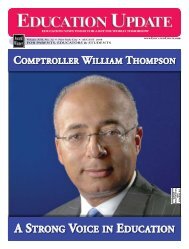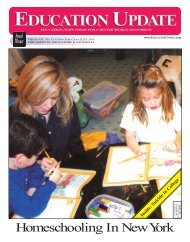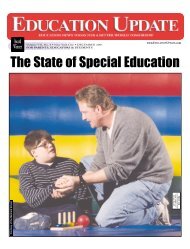Create successful ePaper yourself
Turn your PDF publications into a flip-book with our unique Google optimized e-Paper software.
Review of A School Leader’s GuideTo Excellence: Collaborating OurWay To Better SchoolsA School Leader’s Guide To Excellence:Collaborating Our Way To Better SchoolsBy Carmen Farina and Laura KotchPublished by Heineman: Portsmouth, NH, 2008. (190 pp)By Merri RosenbergAnd here I thought the principal at my children’ssuburban elementary school was simply abrilliant people person, what with her breakfastshonoring community volunteers, regular newslettershome to parents, and cheerful notes acknowledginga child’s special accomplishment or classachievement.Turns out that Rochelle Cohen (the truly giftedretired leader of my now-adult children’sConcord Road Elementary School) must haveabsorbed some of the same lessons that CarmenFarina and Laura Kotch generously share in thisreader-friendly, useful and timely book.Working from a basic premise that true leadershipneeds to be collaborative in order to createa successful school, Farina and Kotch providepractical advice that can be followed by any principal,master teacher, or district superintendent.These authors know what they’re talking about.Farina was Deputy Chancellor for Teaching andLearning of the New York City Departmentof <strong>Education</strong>; Kotch was the department’sExecutive Director of Professional Developmentand Curriculum. They’ve also been classroomteachers, staff developers, college instructors, andprincipals, among other key educational leadershiproles.“<strong>Education</strong> is first and foremost a people business,and the relationships we foster are crucial,”they write.So how does that happen?It starts with a clear vision, Farina and Kotchsuggest—and one that relies on conversationsrather than checklists. Their approach urges leadersto build collaborative communities, withbottom-up change rather than top-down pronouncements.Just as skilled teachers write letters to theirstudents at the beginning of the school year,outlining their hopes and expectations and solicitingsuggestions and ideas from the students, theauthors believe that effective leaders should dothe same thing with their staffs.It doesn’t hurt to embrace some aspects ofcheerleaders, being positive and forward-looking,rather than dwelling on problems. They write,“…Problems cannot define a vision nor becomeits end point. Instead, they are opportunities toinclude stakeholders in formulating the vision.”Basically, the rationale for having a clear visionis to make sure that everyone is on the same page,moving towards the same goals.And they caution leaders not to be overly ambitious,focusing on three priorities each year ratherthan producing an unrealistic laundry list thatcan’t be successful.Being a good leader doesn’t mean winningpopularity contests, whether in the school building,in the district, or in the larger community.“Be willing to take a public stand on unpopularissues,” the authors state. “Principled leaderslook beyond narrow demands such as raisingtest scores and focus their priorities on moreglobal initiatives such as graduating students whoare inventive, analytical, literate, compassionate,artistic and creative human beings.”Farina and Kotch are also proponents of givingfeedback at every opportunity, whether it’swriting a “wow” note to congratulate a teacheron a successful lesson, or sharing insights aboutstrategies to improve student performance ina particular curriculum area. It’s about payingattention to what the people in a school (or district)are doing, and acknowledging their effortsand achievements. Newsletters, press releases,bulletin boards, as well as regular one-on-oneconversations with staff, contribute to developinga culture where people feel valued and respected.The authors have written a user-friendly book,packed with specific strategies and suggestionsthat can easily translate to real-world applications,including as ways to avoid potentialobstacles and identify successes.One idea is launching an internal “Book ofthe Month Club” for teachers and administratorsto discuss at meetings, as a way both to modelhow teachers should work with students and toemphasize the importance of reading and literacyin the school building. Another is finding outways to celebrate milestones in a school, whetherit’s the highlights of staff accomplishments ormonthly birthdays—fun belongs in a school, andattracts parents and community members to bepart of what takes place there.What I found especially valuable was the ideathat September planning should take place inJune of the previous year: “June planning buildsschool wide consistency, results in fewer curriculargaps and redundancies, and establishes sharedhabits of mind…June planning transforms theend of the school year, often a time of low energy,to a time of new beginnings and renewed energy,”write Farina and Kotch.Start reading.#Addicted toAlliterationBy Gillian GranoffMetaphorically manic,Seeking an order from panic,I sing for synechdoche,Heed to hyperbole,Applaud allegory,I smile for simile.A parade of prepositionsEscapes my doors in this addictionTo dictionThat serenades me in soundAnd mélange of meter.JUNE 2008 ■ EDUCATION UPDATE ■ BOOK REVIEWSI climb the wallsIn a cornucopia of capitals,Saturate my ears inA symphony of syllogism.I am grateful for the grammarThat salutes me in syllableCradles me in sound.I am restored to calmFrom the cacophony and storm,And without repetition or rhymeIt restores my sense of time.Logos Bookstore’s RecommendationsThe Case For CivilityBy Os Guinness(Harper One, $23.95)In a world of people and nations who seem tohave grown increasingly polemical, violent anddistrustful towards each other, Os Guinness’ TheCase For Civility is a possible solution. Throughanalyzing as model the American Republic asput forth in the U.S. Constitution and the firstamendment and through the practices of theearly leaders of the United States, the authormakes a case that historically the U.S.A understoodand practiced civility. What Guinness holdsto be civility is a situation where people canrespectfully disagree and present their own viewswithout fear of retribution because they areprotected by society’s laws. This kind of civilityhe finds lacking in much of the present worldespecially among Islamists, many African governments,Burma, Kosovo, and historically inHitler’s Germany, Stalin’s Russia, Mao’s Chinaand Pol Pot’s Cambodia. He does believe that theU.S.A., although once a good model for civilityis now because of the culture wars in danger ofstraying from being a country of civility. He doesnot hold out much hope for Europe as in moderntimes it has become so secular that it does notknow how to deal with passionate immigrantreligious groups.Like his fellow compatriot the late AlistairCooke, Os Guinness, also author of Long JourneyHome, The Call, Unspeakable, and PropheticUntimeliness, is British and has lived in theUnited States for many years. In 1986 he proposedthe idea of the Williamsburg Charter(text of which is included in this book) to ChiefJustice Warren Burger, chairman of the bicentennialcommission of the U.S. Constitution. TheWilliamsburg Charter, of which Guinness wasone of the drafters, was signed June 25, 1988By H. Harris Healy, III, President, Logos Bookstore1575 York Avenue,(Between 83rd and 84th Sts.)New York, NY 10028(212) 517-7292,Fax (212) 517-7197www.logosbookstorenyc.comand is a celebration and reaffirmation of the FirstAmendment, stressing religious liberty.The Case For Civility is a must addition toone’s library, so come pick up your copy atLogos. While at Logos do pick up a copy ofPrince Caspian by C.S. Lewis (the book the newNarnia film is based on.) as well as the otherbooks of the Narnia Chronicles and books aboutNarnia. Meanwhile Logos has attractive Father’sDay cards as well as books and gifts, and graduationcards, books and gifts.Do mark down June 18 on your calendars tocome to Logos at 7 P.M. to hear Marie Brenner,writer-at-large for Vanity Fair, author of thetobacco industry expose, The Man Who KnewToo Much, basis for the 1999 movie, The Insider,read from her latest book, Apples & Oranges.Upcoming Events At LogosWednesday, June 4, 2008 at 7 P.M. KYTVReading Group will discuss Miss Lonelyhearts &The Day Of The Locust by Nathaniel West.Thursday, June 5, 2008 at 7 P.M., Connecting,the Mind, Body And Spirit Workshop.Facilitator Alison Walling works at GoldmanSachs on the Investment Banking Division’sProfessional development and LeadershipTraining Team.Monday, June 9, 2008 at 7 P.M., The SacredTexts Group led by literary agent, Richard Curtis,will continue its discussion of the Gospel ofMatthew.Wednesday, June 18, 2008 at 7 P.M, MarieBrenner will read from her new book, Apples &Oranges and sign copies of the book afterwards.Wednesday, July 9, 2008 at 7 P.M., KYTVReading Group will discuss John Adams byDavid McCullough.Transit: 4,5,6 Subways to Lexington Ave. and86th St. M86 Bus (86th St.), M79 Bus (79th St.).M31 Bus (York Ave.), M15 Bus (1st and 2ndAves.)#Celebrate the Summer withFireworks, Barbecues, andBooks Galore!By Selene VasquezPICTURE BOOK: AGES 6 THRU 8The SandmanBy Ralph Fletcher, Illustrated by Richard Cowdry(Holt, unpaged, $16.95)The dust from the Sandman helps all whosuffer from sleeplessness, especially children.Beautifully plausible story free of adult-orientednostalgia. Vibrant acrylic paintings are as refreshinglystraightforward as the text.NONFICTION: AGES 8 THRU 10United Tweets of AmericaBy Hudson Talbott(Putnam, unpaged, $17.99)“Yankee Doodle went to town, followed bya chicken, if that bird won’t shut his beak, he’sgonna get a licken’.” An amusing rollicking rompthru the states. Wisecrack-filled cartoons featurebirds in trivia-style competition for the “UnitedTweets of American Pageant.”21HurricanesBy Seymour Simon(CIP, 32 pps., $16.99)With new cover art featuring the Smithsonianlogo, this updated edition presents hair-raisingdescriptions and photos of significant disasterssince 2003. The formation and behavior of hurricanesas well as necessary precautions is included.BIOGRAPHY: AGES 6 THRU 10Elizabeth Leads the Way: Elizabeth CadyStanton and the Right to VoteBy Tanya Lee Stone, Illustrated by Rebecca Gibbon(Holt, unpaged, $16.95)This “strong-spirited, rule-breaking” girlbecame the pioneering leader of women’s rights,culminating in her 1848 presentation of theDeclaration of Rights and Sentiments, whichcalled for women’s voting rights. Excellentgouache and colored pencil illustrations in afolk-art style.Selene Vasquez is a media specialist at OrangeBrook Elementary School in Hollywood, FL.#

















